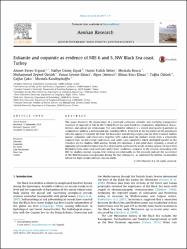Eolianite and coquinite as evidence of MIS 6 and 5, NW Black Sea coast, Turkey

Göster/
Tarih
2017-04Yazar
Güneç Kıyak, NafiyeErginal, Ahmet Evren
Karabıyıkoğlu, Mustafa
Öztürk, Tuğba
Selim, Hamit Haluk
Bozcu, Mustafa
Öztürk, Muhammed Zeynel
Ekinci, Yunus Levent
Demirci, Alper
Elmas, Elmas Kırcı
Çakır, Çağlar
Karabıyıkoğlu, Mustafa
Üst veri
Tüm öğe kaydını gösterKünye
Demirci, A., Güneç Kıyak, N., Ekinci, Y. L., Öztürk, M. Z., Bozcu, M., Çakır, Ç., Öztürk, T. . . . & Karabıyıkoğlu, M. (2017). Eolianite and coquinite as evidence of MIS 6 and 5, NW black sea coast, turkey. Aeolian Research, 25, 1-9. doi:10.1016/j.aeolia.2017.01.004Özet
This paper discusses the implications of a lowstand carbonate eolianite and overlying transgressive sequence of coquinite at Şile on the Turkish Black Sea coast based on composition, depositional characteristics and optical age estimations. The cross-bedded eolianite is a mixed ooid quartz grainstone in composition, yielding a depositional age matching MIS 6. It formed at the backshore of the paleobeach with the supply of sediment the from the beach face and offering insights into the drift of mixed shallow marine carbonates and siliciclastics together with radial ooids by onshore winds from a subaerially exposed high- to low-energy ooid shoals and oolitic sand complexes which developed parallel to the shoreline on the shallow shelf margin. During this lowstand, a low-relief dune retaining a record of opposing paleowind directions than that of prevalent northeasterly winds of today appears to have been lithified to form dune rock (aeolinite) under drier conditions compared to the present. Coinciding with MIS 5e, shallow marine coquina beds resting unconformably on the eolianite indicate the occurrence of the Mediterranean transgression during the last interglacial, as confirmed by benthic foraminifera within the high-salinity tolerant coquina shells.

















